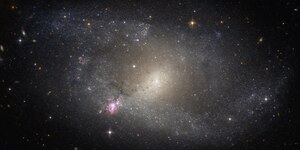NGC 5398
| Galaxie NGC 5398 | |
|---|---|
(c) ESA/Hubble, CC BY 4.0 | |
| Die Galaxie NGC 5398 aufgenommen vom Hubble-Weltraumteleskop. | |
| AladinLite | |
| Sternbild | Zentaur |
| Position Äquinoktium: J2000.0, Epoche: J2000.0 | |
| Rektaszension | 14h 01m 21,5s[1] |
| Deklination | −33° 03′ 50″[1] |
| Erscheinungsbild | |
| Morphologischer Typ | SB(rs)dm[1] |
| Helligkeit (visuell) | 12,6 mag[2] |
| Helligkeit (B-Band) | 13,2 mag[2] |
| Winkelausdehnung | 2,8′ × 1,7′[2] |
| Positionswinkel | 172°[2] |
| Flächenhelligkeit | 14,1 mag/arcmin²[2] |
| Physikalische Daten | |
| Rotverschiebung | 0,004066 ± 0,000010[1] |
| Radialgeschwindigkeit | (1219 ± 3) km/s[1] |
| Hubbledistanz H0 = 73 km/(s • Mpc) | (49 ± 4) · 106 Lj (15,0 ± 1,1) Mpc [1] |
| Durchmesser | 55.000 Lj |
| Geschichte | |
| Entdeckung | John Herschel |
| Entdeckungsdatum | 3. Juni 1836 |
| Katalogbezeichnungen | |
| NGC 5398 • UGC A 379 • PGC 49923 • ESO 384-032 • MCG -05-33-37 • IRAS 13584-3249 • 2MASX J14012155-3303496 • SGC 135826-3249.3 • GC 3734 • h 3552 • | |
NGC 5398 ist eine Balkenspiralgalaxie vom Hubble-Typ SB(rs)dm im Sternbild Zentaur am Südsternhimmel. Sie schätzungsweise 49 Millionen Lichtjahre von der Milchstraße entfernt und hat einen Durchmesser von etwa 55.000 Lj. In NGC 5398 befindet sich das riesige Sternentstehungsgebiet Tol 89, welches Gegenstand gegenwärtiger Untersuchungen ist. Dieses Gebiet hat eine Ausdehnung von 5000 mal 4000 Lichtjahren.[3][4]
Die Galaxie NGC 5398 wurde am 3. Juni 1836 von dem britischen Astronomen John Herschel entdeckt.[5]
Weblinks
- NGC 5398. SIMBAD, abgerufen am 14. Februar 2016 (englisch).
- Starbursts in NGC 5398 (engl.)
- NGC 5398. DSO Browser, abgerufen am 14. Februar 2016 (englisch).
- The massive star population in the giant HII region Tol 89 in NGC 5398
Einzelnachweise
Auf dieser Seite verwendete Medien
(c) ESA/Hubble, CC BY 4.0
Starbursts in NGC 5398
This NASA/ESA Hubble Space Telescope picture shows NGC 5398, a barred spiral galaxy located about 55 million light-years away.
The galaxy is famous for containing an especially extensive HII region, a large cloud composed of ionised hydrogen (or HII, pronounced “H-two”, with H being the chemical symbol for hydrogen and the “II” indicating that the atoms have lost an electron to become ionised). NGC 5398’s cloud is named Tol 89 and sits at the lower left end of the galaxy’s central “bar” of stars, a structure that cuts through the galactic core and funnels material inwards to maintain the star formation occurring there. Tol 86 is conspicuous in being the only large massive star forming complex in the entire galaxy, with an extension of roughly 5000 times 4000 light-years; it contains at least seven young and massive star clusters. The two brightest clumps within Tol 89, which astronomers have named simply “A” and “B”, appear to have undergone two bursts of star-forming activity — “starbursts” — roughly 4 million and less than 3 million years ago respectively. Tol 89-A is thought to contain a number of particularly bright and massive stars known as Wolf-Rayet stars, which are known for their high temperatures and extreme stellar winds.
Credit:
ESA/Hubble & NASA
Coordinates Position (RA): 14 1 22.06 Position (Dec): -33° 3' 49.35" Field of view: 3.38 x 1.69 arcminutes Orientation: North is 99.1° right of vertical Colours & filters Band Wavelength Telescope Optical V 606 nm Hubble Space Telescope ACS Optical V 606 nm Hubble Space Telescope ACS Optical I 814 nm Hubble Space Telescope ACS Optical V 606 nm Hubble Space Telescope ACS Optical I 814 nm Hubble Space Telescope ACS.

